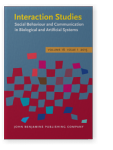Vol. 16:1 (2015) ► pp.1–28
The role of social eye-gaze in children’s and adults’ ownership attributions to robotic agents in three cultures
Young children often treat robots as social agents after they have witnessed interactions that can be interpreted as social. We studied in three experiments whether four-year-olds from three cultures (China, Japan, UK) and adults from two cultures (Japan, UK) will attribute ownership of objects to a robot that engages in social gaze with a human. Participants watched videos of robot-human interactions, in which objects were possessed or new objects were created. Children and adults applied the same ownership rules to humans and robots – irrespective of whether the robot engaged in social gaze or not. However, there was cultural variation in the types of ownership rules used. In Experiment 3, we removed further social cues, finding that just showing a pair of self-propelled robot-arms elicited ownership attributions. The role of social gaze in social attributions to robots and cross-cultural differences in ownership understanding are discussed.
Article outline
- 1.Introduction
- 1.1Eye gaze and social agency
- 1.2The development of ownership understanding
- 1.3Cross-cultural difference in attitudes towards robots
- 1.4Present studies
- 2.Experiment 1
- 2.1Methods
- 2.1.1Participants
- 2.1.2Video stimuli
- 2.1.3Procedure
- 2.1.4Data coding and analyses
- 2.2Results and discussion
- 2.1Methods
- 3.Experiment 2
- 3.1Methods
- 3.1.1Participants
- 3.1.2Video stimuli and procedure
- 3.1.3Data coding and analyses
- 3.2Results and discussion
- 3.1Methods
- 4.Experiment 3
- 4.1Methods
- 4.1.1Participants
- 4.1.2Video stimuli
- 4.1.3Procedure
- 4.1.4Data coding and analyses
- 4.2Results and discussion
- 4.1Methods
- 5.General discussion
- 5.1The role of eye gaze on ownership attributions to robotic agents
- 5.2Cross-cultural development of ownership understanding
- 6.Conclusion
- Acknowledgements
-
References
References
Cited by
Cited by 19 other publications
This list is based on CrossRef data as of 1 june 2024. Please note that it may not be complete. Sources presented here have been supplied by the respective publishers. Any errors therein should be reported to them.
